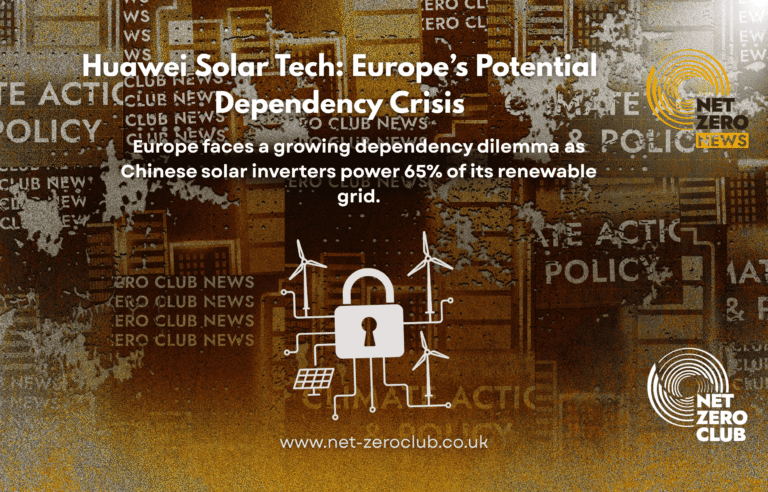Why High Gas Prices, Not Net-Zero, Drive UK Electricity Costs

Welcome, Net Zero News readers,
The ongoing discussions surrounding the UK’s soaring electricity prices have become increasingly political, with various narratives emerging about the causes behind the spike in bills and the most effective strategies for alleviating the financial burden on households. The issue has gained prominence following a significant increase in energy costs that can largely be traced back to geopolitical factors, particularly the disruption of gas supplies from Russia amid the Ukraine crisis.
Since Russia’s invasion of Ukraine in early 2022, gas exports to Europe have been markedly reduced, leading to a global energy crisis that has left the UK particularly vulnerable. With gas accounting for 98% of the wholesale power prices in the country, and the prices being three times higher than pre-crisis levels, households have been faced with record electricity bills. To put this into perspective, the average household electricity bill in the UK has risen from £603 to £926 per year, a staggering 54% increase.
However, amidst the chaos, there has been a concerted effort by some to shift the blame for these high costs onto “green levies” that fund the expansion of clean energy and the UK’s net-zero emissions target for 2050. This narrative, however, overlooks the reality of the situation. According to industry experts, green levies account for a mere 6% of the increase in electricity bills since the start of the crisis, while a considerable 53% is attributable to wholesale prices driven by gas.
In addition, network charges, which represent 20% of the rise in bills, have also been affected by the crisis, particularly due to the fallout from utility firms going out of business and the high costs associated with managing the electricity grid during this tumultuous time. Dhara Vyas, the chief executive of Energy UK, emphasised that the primary driver of soaring electricity bills remains the wholesale costs dictated by gas prices.
This article delves into the factors contributing to the high electricity prices in the UK and examines potential avenues for reducing these costs in the short to medium term. Moreover, it highlights why a transition to clean power is expected to ultimately lead to lower energy bills.
Understanding the High Electricity Prices in the UK
Electricity prices in the UK have been on an upward trajectory since before the geopolitical tensions escalated. Prior to Russia’s invasion of Ukraine, global gas prices had already begun to rise as economies rebounded from the Covid pandemic and restrictions on energy supplies were put in place. The invasion catalysed a drastic reduction in gas deliveries from Russia, previously Europe’s largest supplier, leading to skyrocketing gas prices and, consequently, soaring energy bills for millions of households. The UK government has attempted to alleviate the burden on consumers, spending around £100bn on support during this crisis.
Despite some relief in gas prices from their record highs in 2022, they remain significantly inflated, roughly three times higher than pre-crisis levels. This ongoing exposure to high gas prices is, without a doubt, the dominant factor behind the UK’s elevated electricity prices. Renowned figures in the energy sector, including Dr Fatih Birol, chief of the International Energy Agency (IEA), have stressed that blaming clean energy initiatives for high energy prices is misguided and diverts attention from the actual causes — namely, the gas supply disruptions.
The energy regulator Ofgem has set a price cap for electricity bills, which illustrates the various components of average household costs over the years. A substantial portion of this cap is attributed to wholesale costs, which are primarily influenced by the price of gas. In contrast, green levies have decreased during the height of the gas price spike, highlighting the incongruence between the narrative blaming green initiatives and the actual data.
Key Drivers of Rising Household Electricity Bills
Since 2021, the Ofgem price cap for household electricity has soared, marking a £324 increase, predominantly due to wholesale costs, which have more than doubled during this period. The UK has invested approximately £140bn in gas purchases since the onset of the global energy crisis. Vyas reiterated that wholesale costs, dictated by gas prices, are the primary factors driving up bills, with policy costs, often referred to as green levies, remaining relatively stable.
In terms of the breakdown of costs, approximately £162 of the increase can be directly linked to wholesale prices, while network charges have added £63, and green levies have contributed an additional £18. The remaining increases stem from various other sources. This data underscores the disproportionate impact that wholesale prices have had on overall electricity costs, further validating the argument that high gas prices are the real culprit behind soaring bills.
Interestingly, the rise in network charges is not solely due to the transition towards renewable energy sources. A significant factor has been the fallout from the energy crisis, which resulted in numerous electricity retailers going out of business. The costs associated with bailing these companies out, alongside the exorbitant expenses tied to managing the electricity grid amid fluctuating gas prices, have all contributed to the increase in network charges.
Industrial Electricity Prices and Their Implications
The discussion around high electricity prices extends beyond households to the industrial sector, where businesses have faced significant challenges due to steep energy costs. Reports have surfaced indicating that the UK boasts some of the highest industrial electricity prices globally, a narrative that has gained traction in political circles. However, this discourse often overlooks the critical role that gas prices play in driving these costs.
Despite the UK steel industry being exempt from environmental levies and receiving relief under the government’s “supercharger” scheme for network costs, the sector still grapples with high electricity prices primarily due to the inflated gas prices. The misconception that net-zero policies are the root cause of high industrial electricity prices has been propagated by various political figures, such as Kemi Badenoch, who recently denounced the UK’s commitment to its 2050 net-zero target.
Frank Aaskov, director at UK Steel, has argued that the factors influencing the steel industry’s struggles are multifaceted and not solely attributable to climate policies. He pointed out the significant influence of global market dynamics and trade policies on the industry’s current state. Misattributing the challenges faced by industrial sectors to net-zero initiatives could hinder constructive discussions around the necessary reforms and investments needed to transition to a cleaner energy landscape.
Potential Solutions for Reducing Electricity Prices
As the UK grapples with the financial ramifications of the energy crisis, discussions surrounding potential solutions to alleviate the burden of rising electricity prices have gained momentum. The government’s launch of a review of electricity market arrangements (REMA) in April 2022 was a significant step towards addressing the structural issues within the electricity market. This review aims to explore options to decouple electricity prices from the volatility of gas prices, thereby reducing the financial strain on consumers.
While some options, such as “pay-as-bid” pricing, have been ruled out, the government is still considering alternatives that may help mitigate the impact of gas prices on electricity costs. The ongoing debate has highlighted the possibility of transitioning to a regional market with zonal pricing, which proponents argue could lead to a more efficient electricity system and potentially lower costs for consumers in the long run. However, this proposal has faced pushback from various stakeholders concerned about the potential implications for investment and market stability.
Energy UK has outlined several short-term strategies that could be employed to reduce electricity bills, including optimising the energy system, investing strategically in infrastructure, and embracing smart technologies to enhance efficiency. For instance, households equipped with flexible technology, such as batteries and electric vehicles, could save significantly by adjusting their consumption patterns to align with periods of lower demand.
The Future of UK Electricity Costs and Climate Goals
Looking ahead, the UK government aims to achieve a fully decarbonised power system by 2030, with a commitment to expanding renewable energy sources and enhancing energy storage capabilities. This ambitious goal is expected to significantly reshape the energy landscape and has the potential to lead to lower household energy bills over time. While some concerns have been raised about the costs associated with this transition, credible analyses suggest that the move towards clean energy will ultimately reduce bills by insulating consumers from the volatility of gas prices.
As the UK progresses towards its climate goals, the need for substantial investments in clean energy infrastructure is clear. Estimates suggest that an annual investment of around £40bn will be necessary to meet the targets set for 2030. However, the long-term view is optimistic; a clean energy system is projected to result in lower overall energy costs, benefiting consumers and enhancing energy security.
In summary, while the immediate challenges posed by high electricity prices are significant, the transition to a clean energy future presents a viable path towards reducing costs and ensuring long-term sustainability. By focusing on reducing reliance on fossil fuels and investing in renewable energy sources, the UK can pave the way for a more secure and affordable energy system for all.

 Got net-zero news, project updates, or product launches to share?
Got net-zero news, project updates, or product launches to share? 


